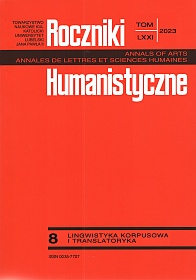Analogia figuratywna (metafora i obrazowanie) w Daodejingu 道德经
Figurative Analogy (Metaphors and Images) in Dao De Ying 道德经
Author(s): Lidia KasarełłoSubject(s): Language and Literature Studies, Sociolinguistics
Published by: Towarzystwo Naukowe KUL & Katolicki Uniwersytet Lubelski Jana Pawła II
Keywords: figurative analogy; metaphors; images; Daodeying
Summary/Abstract: The figurative language in the Dao De Ying, which involves the creation of images and meanings through the use of analogies, metaphors and symbols, is a hermeneutically open text. It represents a part of the broader strategy of correlative (coordinated) thinking, typical of the ancient Chinese hemisphere. The basic category, around which the whole meaning of the Dao De Jing is woven, is dao. As a target domain, it appears – according to Feng Youlan – in four aspects: ontological, cosmo-genetic, phenomenological and characterological (1983, 77). Laozi appeals to the most primordial structures of thought to explain what dao is, which is that it has no explicit material designation in the real world and remains elusive beyond context and figurations. In the text itself, it serves as an ontological metaphor. From a cognitive point of view, Laozi uses the technique of mapping objects from one system resource to another. Among these are conceptual metaphors derived from the source domain. Those domains, discussed successively in this paper, are connected by the conviction of the organic nature of the universe. They come both from the natural world, e.g. water and the valley; the human domain, e.g. the figure of a mother, a woman, an infant; and from the world of flora and fauna, as well as objects in the human environment, e.g. the wheel and the hub, the uncarved block, the jug, the bellows, the bow, straw dogs and nets. Their function, due to the choice of associative thinking (analogising), remains the same, while they are differentiated by the type of metaphors used, from situational to static.
Journal: Roczniki Humanistyczne
- Issue Year: 71/2023
- Issue No: 9
- Page Range: 17-38
- Page Count: 22
- Language: Polish

